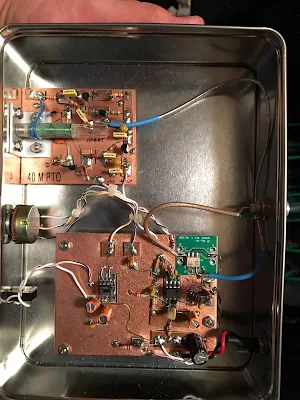Gents,
Here’s my newest creation.
It’s a PTO tuned receiver for 40 meters and uses the WA6OTP PTO circuit I built a couple years back. I believe I had sent you a picture of it then. I bought the tuning assembly from him which is the aluminum bracket, acrylic tube fitted with Pem nut, and brass screw. The circuit uses a J310 as oscillator transistor and several bipolar transistors for amplification and buffering.
This feeds a ADE-1 mixer, mounted on a little breakout board I bought from RfBay.
Years ago I had good luck building the Rock Bending Receiver from the ARRL handbook, so I took the audio chain from it and incorporated it. It uses a TL072 and a LM 386.
As of now I haven’t needed any kind of front end filter, but am working on a 40 meter bandpass filter from Hans Summers that I will put on the input just in case it’s ever needed.
I had been looking for an easy enclosure and found this in one of the break rooms at work. An empty Christmas nut tin.
The PTO screw goes in and out like a turtle sticking its head out of the shell, plus my 13 year old son Alex’s favorite animal is a turtle. So it goes.
Chris
KD4PBJ













